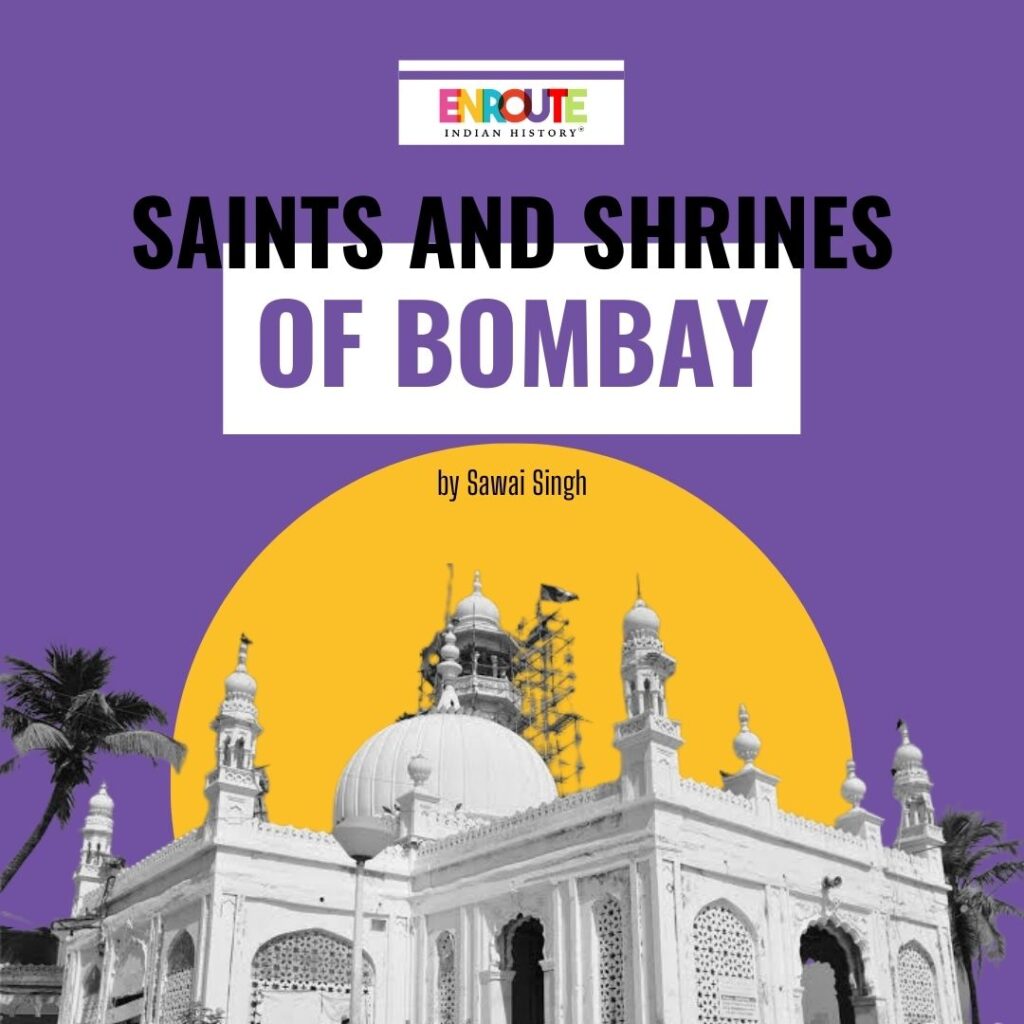
Article Written By EIH Researcher And Writer
Sawai Singh Panwar
Mumbai, earlier known as Bombay, derived its name from the goddess Mumba devi of the Koli (fishermen) community and came under the garb of the British from Portuguese domination in the year 1661. Since then the ghost of British capitalism has been etched in the memory of Bombay. Surprisingly, from the 19th-20th century onwards Bombay was turned into a land of vibrant stories of holy men who were of foreign origin. This was followed by the churning of saint-shrine culture surrounding them which was unique. The catalyst working here was capitalism which shaped and gave a push to more such stories through labour culture, that ensured a safe space for migrants in the foreign land. This article aims to peek into the anecdotes, practices and traditions related to three categories of saint shrines- healers, popular and controversial- and their repercussions on people’s life under colonialism.
The first three shrines discussed are providers of healing services in different ways. Bawa Gor is one of the Sidi saints, who, according to the legends, was an itinerant soldier from East Africa. Sidi are people of African origins who settled in India through oceanic migration and then intermingled their native traditions with Gujarat’s sufi-shrine traditions. Baba Gor’s shrine, like other Sidi shrines of Bombay, was a ‘satellite’ that travelled from Ratanpur (Gujarat) to the Dongri region via Gujarati Muslims and Iranians. At Bombay, his current custodians date the origin of his abode to the 1880s. Initially, his appeal centred around East Africans and Afro-Indians who were employed as coalers and boiler room assistants in the steamship industry. But gradually, with an increase in the diverse flock of people coming to him, the donations helped the shrine’s growth leading to the construction of a small domed building.
The fusion of traditions becomes visible. For instance, the rituals included dancing ceremonies, Damali and Chinuhhi dances, and ratib performance that was central to black Zanzibari (Indian Ocean island) Muslims. These performances gave a dose of entertainment as well as served the magical purpose of curing black magic and possession. The participation of women and lower class workers became a highlight of this place, even during the Thursday night gatherings, which lasted from 10 pm to 3 or 4 am. Doesn’t this sound like a liberating experience or an escape point even under the dark shadows of the British period?
Shaykh Makhdum Ali dargah has a lot of captivating details attached to it. Initially located at Mahim in Gujarat, it later became a territory of Bombay where he was given Arab ancestry in a hagiographical source called Zamir al-insan (1875). The alteration in the geographical ownership caused a shift in his clientage from the hands of royal power in pre-colonial times, to the Konkani Muslims family in 1863. At present, it has been taken care of by Pir Makhdum Charitable Trust since 1900.

MAKHDOOM ALI DARGAH
Healing at Ali’s shrine could be attained by chanting formulas prescribed on cheap print pamphlets that got popularised due to the advent of print culture; through feeding poor people depending upon the recommendation of the text; and by the holy men dwelling within the shrine (as healers or custodians) who helped in getting rid of buri nazar (evil eye) at a fixed price from eight annas to one rupee. The last practice is reminiscent of the plot point of the Hindi film Haunted (2011) where the protagonist gets help from a faqir or Pir baba of a shrine to save a girl. Such practices still exist in many parts of India.
Besides healing, there are two additional engrossing facts about this place. First is the intrigue value triggered by the proximity of the police station as well as its involvement in the dargah’s festivities. It is so because, according to a popular narrative, a constable’s life was saved by the saint against a gang of smugglers during the colonial period. Secondly, the celebration of the Urs festival (death anniversary) entered the Bombay Gazetteer’s list (1909) due to its popularity. It did not just offer an indigenous variety of entertainment through love songs (ghazals), parades of dancers and diversified stalls and booths, but simultaneously countered the culture of bars and music halls that the Europeans were facilitating.
The shrine of Miran Ali Datar (d. 1492) deems best as a place to witness the magic of life and death under the same roof. Spooky, right? This dargah is situated on Sam Dattar Road, a slum in Mazgaon (Bombay), next to dockyards where the poor working population existed. It was built by a Gujarati Muslim as a replica mausoleum in the early 1900s. His legend reveals him as a saintly warrior supposedly of Bukhara origin, who acquired the power of healing and was buried originally in Unava (Gujarat). This makes the shrine a product of a labour migration pattern that re-constructed older cults in a newer setup.

MAIN ENTRANCE OF THE SHRINE OF HAZRAT ALI MIRA DATAR
© Tewfic El-Sawy-All Rights Reserved
The dargah specialises in the cure of spells from black magic, evil spirits and tantra. It is visited by pilgrims, epileptics, lunatics and the possessed daily. Some of them even end up spending several days lying on the floor or chained in the hope of getting cured through amulets, magic potions and exorcism. Therefore, the atmosphere of the shrine remains intensified due to the above reasons as well as relative darkness, loud prayers and screams of possessed people. Not all prayers or mantras work and in some unfortunate cases, parents leave their deceased child’s body for some time, in case of any chance of resurrection.


A WOMAN IN CHAINS & MAN IN TRANCE
© Tewfic El-Sawy-All Rights Reserved
A rational mind may think of this as superstition and may question the practicality of such places. Since hospitals were not developed in those times, and even today are not feasible for the poor strata, hence indigenous practices interweaved spiritual-somatic perspectives on mental illness and its treatment. To counter such spaces, Lunatic Asylums came into being, which Britishers developed by projecting the Indian treatment practices as stagnant and superstitious. As a result, they imprisoned or even admitted religious mendicants like sadhus and fakirs in these asylums. At the same time, they could never win the trust of the masses in Bombay.
Hajji Ali Dargah remains a popular saint-shrine due to its enchanting location between land and sea and being featured in many films like Coolie and Fiza. Dated somewhere around the mid-19th century, the legends attached to him vary based on his caretakers, chroniclers and devotees’ versions. But according to the widespread rumour, he was a wealthy local merchant who drowned in the sea during his travel to Mecca. His body then finally reached the Bombay shore, under mysterious circumstances, where at present his shrine is located. During colonial times, his shrine gave protection to the travellers who visited him before boarding their ships. It also attracts a humongous amount of worshippers across different religions and their footfalls have seen an increase since its establishment, especially during Urs and Eid celebrations. His as well as Mahimi’s dargah is a wealthy institution and well-known beyond the geography of Bombay. The Trust handling the affairs of the dargah fell into controversy in 2012 when they imposed a ban on the entrance of women. This infuriated the women and a petition was filed which led to the High Court’s order of uplifting the ban imposed by the Trust.


HAJJI ALI DARGAH
© HAJJI ALI DARGAH TRUST
The last entry makes up an intriguing case of complex politics surrounding the dual identity of a saint named Hajji Malang. Although his dargah is likely from a much earlier period, it emerged as a major site only during the 19th century. Due to its spectacular territorial location on the top of a perpendicular rock standing and being close to a railway station, the dargah became accessible for frequent visits by the migrant workers who actively participated in the ‘Urs festival.

HAJJI MALANG DARGAH
A famous legend about him narrates that when Hajji Malang, an Arab missionary, arrived in Kalyan, it was under the garb of oppression and infidelity of Devi’s jaadu (goddess’s magic) who compelled everyone to worship her. This was followed by a war between Malang and his companions versus the goddess. Towards the end, while his fellow mates were becoming lifeless, the saint chanted Allah’s name which resulted in turning the Devi and her followers into stone. It is believed that the remains of stone-turned devi are still present.
This version may seem like a war against Islam and Hinduism, right? But one cannot apply the modern-day communitarian labels to a legend born in medieval times. Instead, this narrative is historically suggestive of the competition that existed amongst regional saints, against each other to gain followers or patronage. Therefore, the image of devi here is symbolic of oppression and the saint’s intrusion speaks of his power that can tackle any form of oppression.
Like the contemporary politics unfolding in the North Indian states where roads or monuments based on Muslim names/origin are being re-named in a Hindu fashion, the story of Hajji Malang too faced a similar twist in the tale. The story took a turn once the Arya Samaj was founded in Bombay during the 1890s which aimed at Hindu-izing the Muslim shrines and Hajji Malang too could not escape from their clutches. Accordingly, Malang’s dargah is a memorial (samadhi) of yogi Machindranath, and hence the shrine was demanded for handover to the Hindus. Thankfully, the shrine still carries its original essence with a complex organization of trustees who are partly Brahmins and Muslims. The dargah experiences pilgrims from all walks of life, including sadhus and transgenders who visit Malang’s adopted daughter, buried next to him.
This case is similar to the famous Shirdi Sai Baba, who has been Hinduized by the Shiv Sena to an extent that his Sufi identity is now lost within the pages of history.
This was the “Islam of Bombay” that historian Nile Green talked about in his book. The stories of these saints opened up a window to explore how Islam interacted and was witnessed by the urban environment. It gave a sense of comfort and escape to working migrants across the world in terms of music, dance and shops. These saints coexisted as well as competed for their prominence based on their pilgrim’s clientage. More such stories can be heard by paying a visit to any nearby holy shrine to enjoy the taste of multiple-layered narratives. In the end, we can ask one question ourselves: How many such saint stories, in reality, we know are Islamic or Hindu from their genesis?
BIBLIOGRAPHY
Chari, Mridula. Why Mumbai police detectives are lining up at the tomb of a 14th-century Sufi saint this week, Scroll.in, Dec 26, 2015.
Doi: https://blog.ipleaders.in/no-entry-haji-ali-dargah/
Green, Nile. “Cosmopolitan Cults and the Economy of Miracles” in Bombay Islam: The Religious Economy of the West Indian Ocean, 1840–1915. Cambridge University Press, 2011.
Papas, Alexander. “Chapter 11 Bombay Mystical City: Muslim Shrines and Saints in the Urban Fabric from 1800 to Present” in Saintly Spheres and Islamic Landscapes. Brill, 2021, pp 335–365.
Pinto, Sarah Ann. “Conclusion” in Lunatic Asylums in Colonial Bombay: Shackled Bodies, Unchained Minds. Palgrave MacMillan, 2018.
Srivastava, Samriddhi. No entry – Haji Ali Dargah, iPleaders, December 27, 2020.
IMAGE SOURCES –
Makhdum Ali Dargah:
https://aalequtub.com/hazrat-makhdoom-ali-mahimi-%E2%80%8E/
Hajji Ali Dargah: http://www.hajialidargah.in/hajiali_sanatorium13.html
Hajji Malang Dargah photo: http://dargahinfo.com/DargahDetails.aspx?DargahID=19
Miran Ali Datar photos: https://thepossessedofmiradatar.wordpress.com/2011/03/15/the-possessed-of-hazrat-sayid-ali-mira-datar/



















